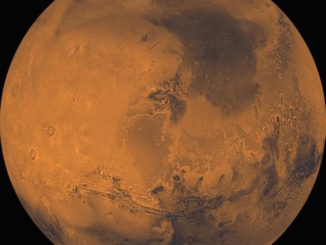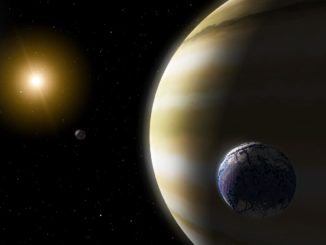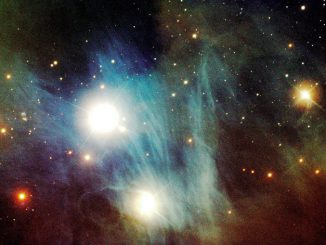
Search Results for planetary migration


Kepler-223 star system has four mini-Neptunes in synchronised orbits
A four-planet system orbiting the star Kepler-223 in the constellation Cygnus is actually a rarity: Its planets, all miniature Neptunes nestled close to the star, are orbiting in a unique resonance that has been locked in for billions of years. For every three orbits of the outermost planet, the second orbits four times, the third six times and the innermost eight times.


Possible exomoon signal found
Strong hints have been found of a possible exomoon candidate orbiting a gas giant planet over 4,000 light years away in the constellation of Cygnus the Swan. Should the moon be confirmed later this year by the Hubble Space Telescope, it will be the first moon ever discovered around a planet beyond our Solar System.

Astronomers capture best view ever of disintegrating comet
The sharpest, most detailed observations of a comet breaking apart have been captured with the NASA/ESA Hubble Space Telescope. The images suggest that the roughly 4.5-billion-year-old comet, named 332P/Ikeya-Murakami, may be spinning so fast that material is ejected from its surface. The resulting debris is now scattered along a 3,000-mile-long trail.


Newborn giant exoplanet found orbiting close to its parent star
A team of astronomers has confirmed the existence of a young planet known as K2-33b, only 11 million years old, that orbits very close to its star (at 0.05 astronomical units), with an orbital period of 5.4 days. Approximately five times the size of the Earth, the new planet is a “super-Neptune” and the youngest such planet known.

Understanding stellar adolescence through T-Tauri stars
A newborn star typically goes through four stages of adolescence. It begins life as a protostar, accreting material and developing a proto-planetary disc. Slowly, stellar winds and radiation blow away the surrounding shell of gas and dust. Next, when the surrounding envelope has cleared, is called the T-Tauri phase. Finally, accretion stops and the source’s radiation comes from the star’s photosphere.

A highly eccentric “hot Jupiter” exoplanet
Astronomers have observed the extreme temperature variations of HD 80606 b, a Jupiter-sized exoplanet with a highly eccentric, comet-like orbit that brings it scorchingly close to its parent star every 111 days. The researchers also calculated the planet’s rotation rate — the first exoplanet rotation rate ever obtained.

‘Cannibalism’ between stars
Stars are born inside a rotating cloud of interstellar gas and dust. Before finding itself on the star, however, most of the cloud lands onto a circumstellar disc forming around the star. The manner in which the material is transported through the disc onto the star, causing the star to grow in mass, has recently become a major research topic in astrophysics.
